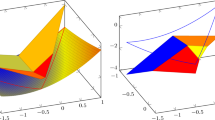Abstract
We study the influence of different strategies for selecting the next box for subdivision in an interval branch and bound method for global optimization. A theoretical result establishes the optimality of a ‘best-first’ strategy. Moreover, we define a multisection algorithm for subdivision of boxes. Different possibilities for the choice of bisection directions and the number of bisections are compared by numerical results showing that multisection is usually superior to bisection. In addition, we identify crucial properties of a division strategy which yield convergence of an algorithm with multisection.
Zusammenfassung
Wir untersuchen den Einfluß verschiedener Strategien zur Auswahl der als nächstes zu teilenden Box in einem Branch-und-Bound-Verfahren zur globalen Optimierung. Ein theoretisches Resultat zeigt die Optimalität einer ‘best-first’-Strategie. Außerdem definieren wir einen Multisektions-Algorithmus zum Teilen von Boxen. Verschiedene Möglichkeiten für die Wahl der Halbierungsrichtungen und die Anzahl der Halbierungen werden anhand numerischer Ergebnisse verglichen, wobei deutlich wird, daß Multisektion der Bisektion immer überlegen ist. Zusätzlich identifizieren wir zwei wesentliche Eigenschaften für Teilungsstrategien, die zur Konvergenz von Algorithmen mit Multisektion führen.
Similar content being viewed by others
References
Alefeld, G., Herzberger, J.: Introduction to interval computations. New York: Academic Press, 1983.
Baumann, E.: Optimal centered forms. BIT28, 80–87 (1988).
Berner, S.: Parallel validated global optimization. ZAMM “Numerical Analysis, Scientific Computing, Computer Science” (special volume) (1996).
Berner, S.: Ein paralleles Verfahren zur verifizierten globalen Optimierung. Dissertation, Bergische Universität GH Wuppertal, 1995.
Csendes, T., Ratz, D.: Subdivision direction selection in interval methods for global optimization. SIAM J. Numer. Anal. (1997) to appear.
Hansen, E.: Global optimization using interval analysis: The one-dimensional case. J. Optim. Theory Appl.29, 331–344 (1979).
Hansen, E.: Global optimization using interval analysis — the multidimensional case. Numer. Math.34, 247–270 (1980).
Hansen, E.: Global optimization using interval analysis. New York: Marcel Dekker, 1992.
Henriksen, T., Madsen, K.: Use of a depth-first strategy in parallel global optimization. Tech. Report 92-10, Institute for Numerical Analysis, Technical University of Denmark, Lyngby, 1992.
Jansson, C.: On self-validating methods for optimization problems. In: Topics in validated computations (Herzberger, J., ed.), pp. 381–438. New York: Elsevier, 1994.
Kearfott, R. B.: Preconditioners for the interval Gauss-Seidel method. SIAM J. Numer. Anal.27, 804–822 (1990).
Leclerc, A.: Parallel interval global optimization and its implementation in C++. Interval Comput.3, 148–163 (1993).
Moore, R. E., Hansen, R., Leclerc, A.: Rigorous methods for global optimization. In: Recent Advances in global optimization (Floudas, C. A., Pardalos, P. M., eds.), pp. 321–342. Princeton: Princeton University Press, 1992.
Neumaier, A.: Interval methods for systems of equations. Cambridge: Cambridge University Press, 1990.
Rall, L.B.: Automatic differentiation: techniques and applications. Lecture Notes in Computer Science, Vol. 120. New York: Springer, 1981.
Ratschek, H., Rokne, J.: New computer methods for global optimization. Chichester: Ellis Horwood, 1988.
Ratz, D.: On branching rules in second-order branch-and-bound methods for global optimization. In: Scientific computing and validation (Alefeld, G., Frommer, A., Lang, B., eds.), pp. 221–227. Berlin: Akademie-Verlag, 1996.
Ratz, D., Csendes, T.: On the selection of subdivision directions in interval branch-and-bound methods for global optimization. J. Global Optim.7, 183–207 (1995).
Törn, A., Žilinskas, A.: Global optimization. Berlin, Heidelberg, New York, Tokyo: Springer, 1989.
Walster, G., Hansen, E., Sengupta, S.: Test results for a global optimization algorithm. In: Numerical optimization 1984 (Boggs, P., Byrd, R., Schnabel, R., eds.), pp. 272–287. Philadelphia: SIAM, 1985.
Author information
Authors and Affiliations
Rights and permissions
About this article
Cite this article
Berner, S. New results on verified global optimization. Computing 57, 323–343 (1996). https://doi.org/10.1007/BF02252252
Received:
Revised:
Issue Date:
DOI: https://doi.org/10.1007/BF02252252




